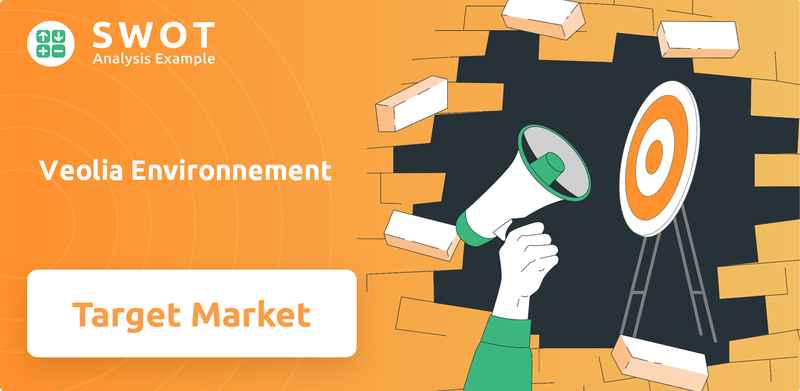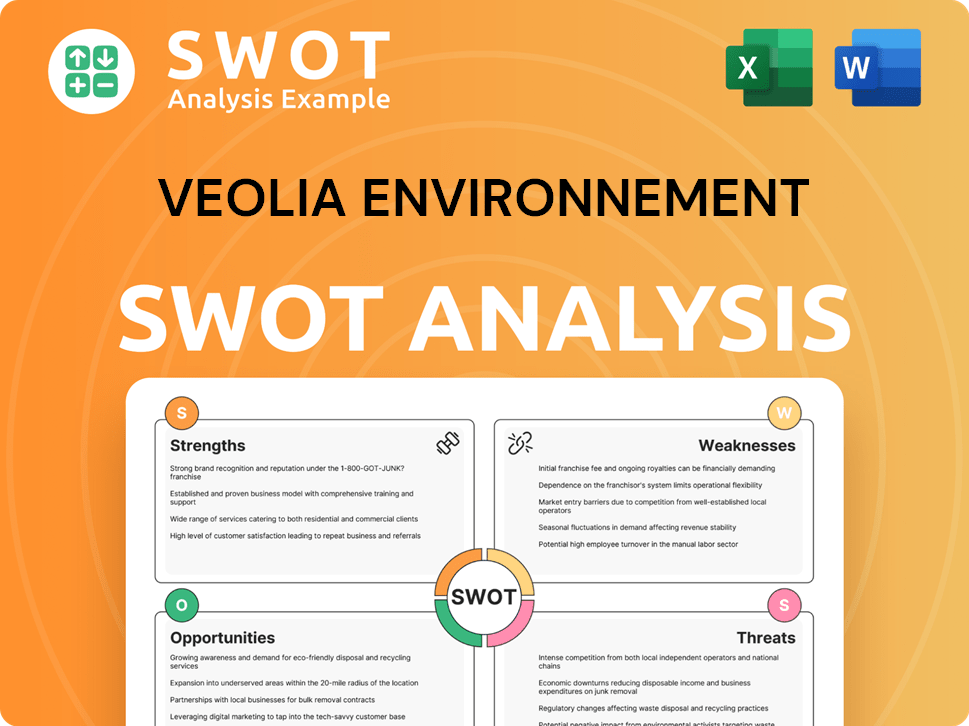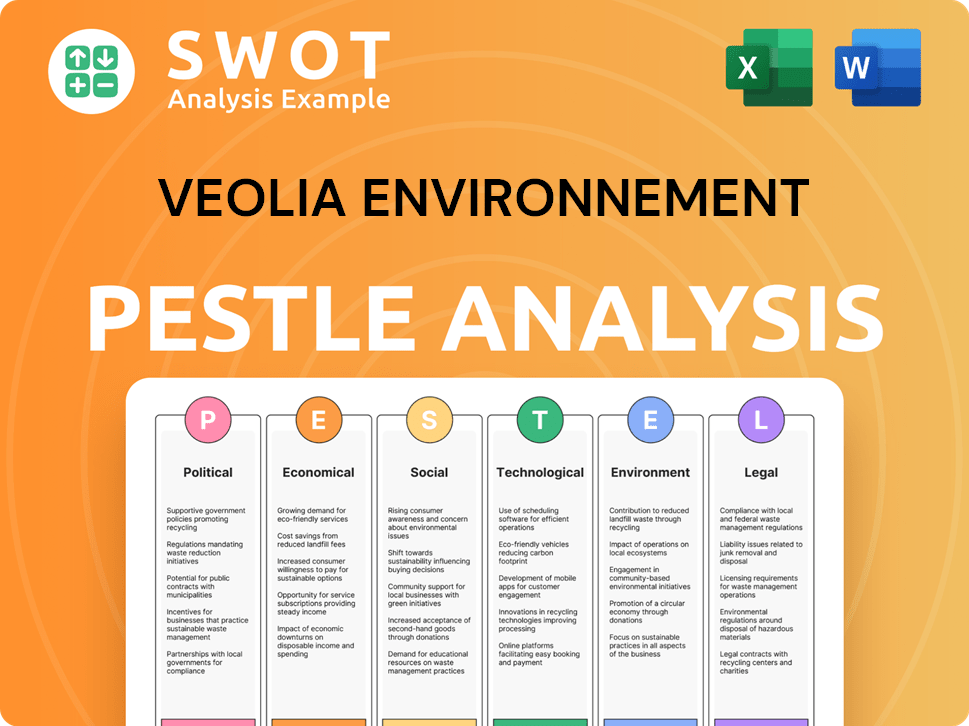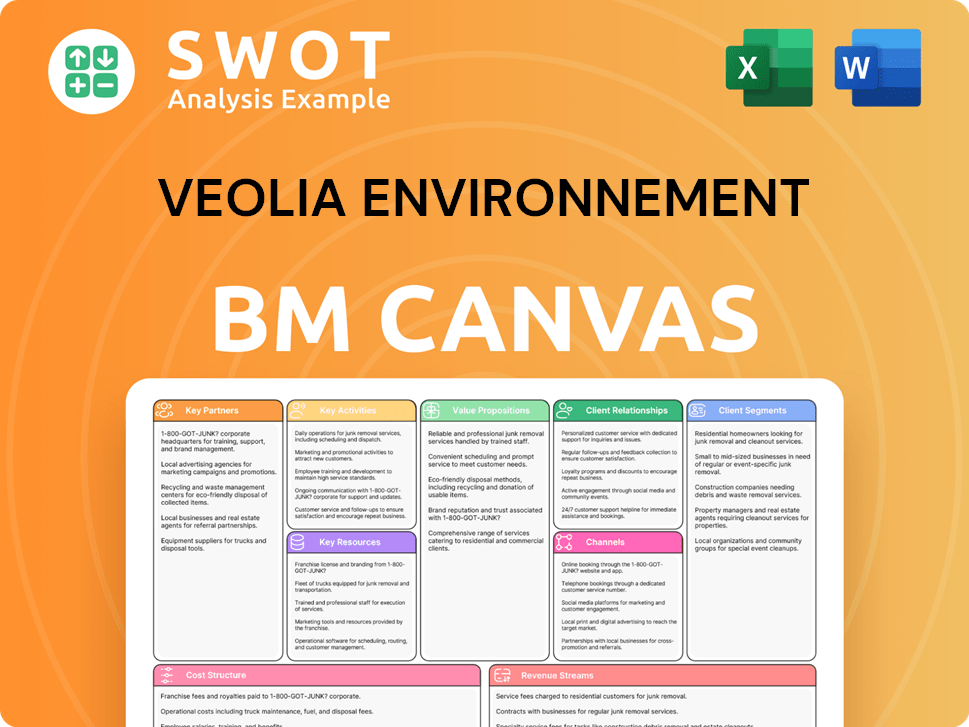Veolia Environnement Bundle
Who Does Veolia Environnement Serve in Today's World?
In today's rapidly evolving market, understanding customer demographics and target markets is crucial, especially for a global leader in environmental solutions like Veolia Environnement. The increasing global focus on sustainability and the circular economy has fundamentally reshaped how companies, including Veolia, must understand and adapt to their customer base. This shift towards greater environmental awareness and the demand for sustainable practices has significantly impacted the market landscape.

Veolia Environnement, initially focused on water services, has dramatically expanded its scope to encompass waste management and energy services. This evolution necessitates a deep dive into its current diverse customer base. This Veolia Environnement SWOT Analysis will help us understand who Veolia's customers are, their specific needs, and how Veolia strategically adapts its offerings. This market analysis is essential to understand the company's market positioning and customer acquisition strategy.
Who Are Veolia Environnement’s Main Customers?
Understanding the customer demographics and target market for Veolia Environnement is crucial for investors and stakeholders. Veolia, a global leader in environmental services, primarily operates in the Business-to-Business (B2B) and Business-to-Government (B2G) sectors. This means its focus is on serving other businesses and governmental entities rather than individual consumers.
The company's target market is broad, encompassing various industries and public sectors. Veolia's services are essential for managing water, waste, and energy, making its customer base diverse. This article explores the key segments Veolia serves, offering insights into their needs and how Veolia meets them.
Veolia's customer base is defined by operational scale, regulatory needs, and sustainability goals. The company's approach is tailored to meet the specific requirements of each segment, ensuring effective solutions and long-term partnerships. For more information, you can review the Owners & Shareholders of Veolia Environnement.
Industrial clients represent a significant portion of Veolia's revenue. These clients include manufacturing, chemical, food and beverage, and energy companies. Veolia provides specialized solutions for water treatment, waste disposal, and energy optimization to meet their specific needs.
Municipal and public authorities are another core customer segment. Veolia manages public water supply and wastewater treatment, urban waste collection and processing, and energy efficiency services for public infrastructure. This segment relies on Veolia's expertise for essential public services.
Commercial businesses, including those in the tertiary sector, also utilize Veolia's services. These businesses require waste management and energy efficiency solutions. Veolia provides tailored services to meet the needs of various commercial clients.
Key demographic characteristics include operational scale, regulatory compliance needs, and sustainability objectives. Industrial clients often seek comprehensive solutions to meet environmental regulations and reduce their carbon footprint. Smaller commercial entities might prioritize cost-effective waste collection and recycling services.
Veolia has adapted its offerings to meet evolving demands, particularly in circular economy principles and decarbonization. This shift is driven by global sustainability trends and stricter environmental policies. Veolia is increasingly focused on renewable energy and waste-to-energy solutions.
- The company's focus on circular economy principles.
- Increasing emphasis on resource recovery and decarbonization.
- Expansion into renewable energy and waste-to-energy solutions.
- Adaptation to stricter environmental policies.
Veolia Environnement SWOT Analysis
- Complete SWOT Breakdown
- Fully Customizable
- Editable in Excel & Word
- Professional Formatting
- Investor-Ready Format

What Do Veolia Environnement’s Customers Want?
Understanding the customer needs and preferences is crucial for Veolia Environnement, a global leader in environmental services. Its diverse customer base, including industrial, municipal, and commercial clients, demands solutions that are efficient, compliant, sustainable, and cost-effective. This focus shapes the company's offerings and strategic direction.
The purchasing behaviors of Veolia's customers are often characterized by long-term contracts and performance-based agreements. They prioritize proven expertise and reliability. The decision-making process centers on meeting regulatory requirements, optimizing operational costs, and enhancing environmental performance. These factors drive the demand for Veolia's services across various sectors.
Veolia's customers seek operational resilience, risk mitigation, and the achievement of corporate social responsibility (CSR) goals. They often face challenges such as aging infrastructure, increasing waste volumes, and complex environmental regulations. Veolia addresses these pain points by adapting its products and services to meet specific customer needs.
Veolia's customer base has specific needs and preferences. These are centered on efficiency, compliance, sustainability, and cost-effectiveness. The company tailors its offerings to meet these demands.
- Efficiency: Customers seek solutions that optimize resource use and minimize operational costs.
- Compliance: Meeting regulatory requirements and ensuring environmental protection are paramount.
- Sustainability: Demand for eco-friendly practices and reducing environmental footprints is increasing.
- Cost-Effectiveness: Clients prioritize solutions that provide value and long-term financial benefits.
Veolia Environnement PESTLE Analysis
- Covers All 6 PESTLE Categories
- No Research Needed – Save Hours of Work
- Built by Experts, Trusted by Consultants
- Instant Download, Ready to Use
- 100% Editable, Fully Customizable

Where does Veolia Environnement operate?
The geographical market presence of Veolia Environnement is extensive, spanning across all continents. This global footprint allows the company to target major markets worldwide. Its strong presence is particularly notable in Europe, especially in France, and other developed economies that have robust environmental regulations.
Veolia's operations extend to North America, Asia-Pacific, and increasingly, emerging markets in Latin America and Africa. These regions are experiencing a growing demand for environmental infrastructure. The company's strategy involves adapting technologies to local conditions and forming partnerships to meet regional needs.
The company's growth strategy includes strengthening its presence in countries with rapidly growing industrial sectors and increasing environmental awareness. This approach reflects a balanced portfolio, with mature markets providing stable revenue, and emerging markets offering significant growth potential for environmental solutions. For instance, in 2023, Veolia reported revenues of approximately €45.3 billion, with a significant portion coming from its international operations, demonstrating its global reach.
Veolia's market share is strongest in Europe, benefiting from the EU's environmental policies. The company also has a significant presence in North America, focusing on municipal water and waste management. This geographical diversification helps mitigate risks associated with economic downturns in any single region.
Veolia is expanding its presence in emerging economies, such as China and India, to capitalize on the growing demand for environmental services. These markets offer significant growth potential. This expansion is part of a broader strategy, as detailed in Growth Strategy of Veolia Environnement.
Veolia tailors its offerings to meet the specific needs of each region, considering differences in customer demographics and buying power. This localization includes adapting technologies and forming partnerships with local entities. For example, in 2024, Veolia announced new partnerships in Asia to enhance its local service capabilities.
Veolia segments its target market based on geographical location, customer needs, and regulatory environments. This segmentation allows for more effective marketing and service delivery. This approach enables Veolia to focus on specific customer groups within each region.
The company's approach to the target market involves a deep understanding of customer demographics and preferences. In developed markets, the focus is on advanced technologies and resource recovery, while emerging markets prioritize basic access to essential services and cost-effectiveness. This dual approach allows Veolia to maintain a competitive edge in various regions, ensuring that its environmental services meet diverse needs. In 2024, Veolia's strategic investments in water and waste management projects in emerging markets increased by approximately 15%, reflecting a strong commitment to these regions.
Veolia Environnement Business Model Canvas
- Complete 9-Block Business Model Canvas
- Effortlessly Communicate Your Business Strategy
- Investor-Ready BMC Format
- 100% Editable and Customizable
- Clear and Structured Layout

How Does Veolia Environnement Win & Keep Customers?
The customer acquisition and retention strategies of Veolia Environnement S.A. are carefully designed to align with its business-to-business (B2B) and business-to-government (B2G) focus. The company leverages a multi-faceted approach, emphasizing direct sales, strategic partnerships, and participation in public tenders to secure new clients. Marketing efforts are targeted, utilizing industry conferences and digital content to highlight its technical expertise and sustainability achievements. A strong reputation and a history of successful projects are also key sales tactics.
Retention is a core focus, achieved through high-quality service, dedicated account management, and excellent after-sales support. This includes proactive client facility monitoring, continuous improvement suggestions, and rapid response to operational issues. Customer data and CRM systems are critical for segmenting clients, understanding their needs, and tailoring service agreements. Veolia also fosters long-term relationships through sustainability partnerships and collaborative innovation, which serves as a strong retention tool.
Veolia's approach to customer acquisition and retention is deeply rooted in its commitment to providing comprehensive environmental solutions. This strategy aims to attract clients seeking integrated services across water, waste, and energy management. The company focuses on demonstrating a clear return on investment for environmental solutions, such as cost savings from waste-to-energy projects and improved water quality. This integrated approach not only attracts new clients but also enhances customer lifetime value by deepening relationships and reducing churn rates.
Veolia primarily acquires customers through direct sales forces, strategic partnerships, and competitive bidding in public tenders. These channels are particularly effective in the B2B and B2G sectors. The company's sales teams work directly with potential clients to understand their needs and propose tailored solutions. Partnerships with other industry players expand Veolia's reach and capabilities. Public tenders are a significant avenue, especially for municipal contracts.
Marketing strategies include participation in industry conferences and specialized trade publications. Digital content marketing is used to showcase technical capabilities and sustainability achievements. Veolia leverages its strong reputation and track record of successful projects as a key sales tactic. The company actively engages with potential clients through informative content and thought leadership, building trust and credibility.
Retention strategies center on delivering high-quality, reliable, and innovative solutions, fostering long-term relationships through dedicated account management, and providing excellent after-sales service. Proactive monitoring of client facilities, continuous improvement suggestions, and rapid response to operational issues are crucial. Veolia's commitment to sustainability partnerships and collaborative innovation also acts as a powerful retention tool.
Customer data and CRM systems are crucial in segmenting clients, understanding their evolving needs, and tailoring service agreements. Data analytics helps identify opportunities for optimization and predict maintenance needs. This data-driven approach allows Veolia to provide customized solutions, enhancing customer satisfaction and loyalty. Analyzing customer data is essential for understanding market trends and anticipating future needs.
Veolia monitors several KPIs to measure the effectiveness of its customer acquisition and retention strategies. These include customer acquisition cost (CAC), customer lifetime value (CLTV), and customer churn rate. In 2024, the company reported a CLTV of approximately €350 million, highlighting the success of its retention efforts. The churn rate was maintained at less than 5% through proactive customer service and innovative solutions. These metrics help Veolia refine its strategies and ensure long-term customer relationships.
- Customer Acquisition Cost (CAC): Measures the cost of acquiring a new customer.
- Customer Lifetime Value (CLTV): Predicts the total revenue a customer will generate during their relationship with Veolia.
- Customer Churn Rate: Indicates the percentage of customers who stop using Veolia's services over a given period.
- Net Promoter Score (NPS): Gauges customer loyalty and satisfaction.
Veolia Environnement Porter's Five Forces Analysis
- Covers All 5 Competitive Forces in Detail
- Structured for Consultants, Students, and Founders
- 100% Editable in Microsoft Word & Excel
- Instant Digital Download – Use Immediately
- Compatible with Mac & PC – Fully Unlocked

Related Blogs
- What are Mission Vision & Core Values of Veolia Environnement Company?
- What is Competitive Landscape of Veolia Environnement Company?
- What is Growth Strategy and Future Prospects of Veolia Environnement Company?
- How Does Veolia Environnement Company Work?
- What is Sales and Marketing Strategy of Veolia Environnement Company?
- What is Brief History of Veolia Environnement Company?
- Who Owns Veolia Environnement Company?
Disclaimer
All information, articles, and product details provided on this website are for general informational and educational purposes only. We do not claim any ownership over, nor do we intend to infringe upon, any trademarks, copyrights, logos, brand names, or other intellectual property mentioned or depicted on this site. Such intellectual property remains the property of its respective owners, and any references here are made solely for identification or informational purposes, without implying any affiliation, endorsement, or partnership.
We make no representations or warranties, express or implied, regarding the accuracy, completeness, or suitability of any content or products presented. Nothing on this website should be construed as legal, tax, investment, financial, medical, or other professional advice. In addition, no part of this site—including articles or product references—constitutes a solicitation, recommendation, endorsement, advertisement, or offer to buy or sell any securities, franchises, or other financial instruments, particularly in jurisdictions where such activity would be unlawful.
All content is of a general nature and may not address the specific circumstances of any individual or entity. It is not a substitute for professional advice or services. Any actions you take based on the information provided here are strictly at your own risk. You accept full responsibility for any decisions or outcomes arising from your use of this website and agree to release us from any liability in connection with your use of, or reliance upon, the content or products found herein.